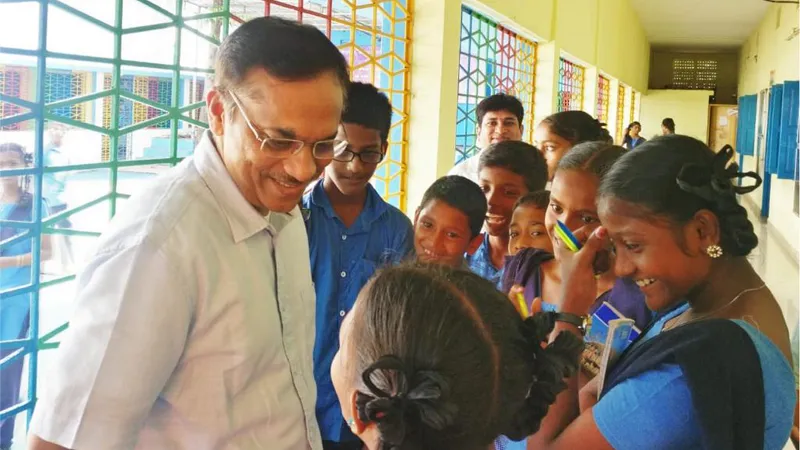How this enterprise is enhancing the quality of education in rural India through digital learning
Noida-based Schoolnet has created an integrated digital solution linking in-school teaching-learning with after-school services through personalisation of content and a hybrid model of delivery of quality education.
Despite being one of the largest K-12 education systems in the world with 1.5 million schools and 250 million school-going children, India is witnessing a widening education gap.
According to reports, approximately 90 percent of students study in government, affordable aided, and unaided private schools. They form the middle and the bottom of the pyramid (MBOP) K-12 segment, and are significantly impacted by the learning crisis.
Several studies estimate that half of the Indian students do not achieve even basic proficiency levels in school – with students from the lowest economic quintiles being impacted the most.
Noida-based is trying to bridge this gap by providing digital and digitally-enabled services to K-12 schools and students in the MBOP segment.
Schoolnet’s mission is to expand lifelong learning opportunities for all, and democratise education by harnessing the power of technology and ecosystem partnerships.

RCM Reddy interacting with the children
RCM Reddy, MD and CEO, Schoolnet, and a former IAS officer, says, “Back in 1997, when Schoolnet was incubated, the question was: how do we remove barriers to accessing quality education at scale? We needed to empower learners and democratise education. In order to do that, we needed curriculum aligned multi-sensory content that students could consume depending on their styles of understanding to internalise concepts.”
Starting up
Schoolnet wanted to bring various types of content together – multimedia, animation-based, simulation-based, and others. The idea was to bring in elements of the constructivist and blended approaches, with theories of multiple intelligence in the development of pedagogically sound content.
“The inspiration behind Schoolnet was to create learning impact at scale for those at the middle and bottom of the pyramid who are suffering from learning poverty. The challenge for us was how to disseminate such content to the remotest corners of the country. We then partnered with IIT Bombay and designed and developed the world’s first teaching-learning device or community computer called K-Yan (K: Knowledge, Yan: Vehicle in Sanskrit),” Reddy says.
K-Yan combined the functionality of a computer, a projector, and other features such as an audio system, video conferencing etc. into a single interactive device. It was built so content could be loaded and ported from place to place, to transform classrooms into digitally-led learning environments.
Digitising schools
Schoolnet follows a ‘phygital’ approach, combining the benefits of traditional learning with online learning to create a blended ecosystem. The idea is to bring in technology-enabled adoption and personalisation of education at scale, especially for the MBOP segment.
“With training of teachers and content, we delivered this across the government and private sector, and established our presence across 100,000 schools in the country via digital classrooms. These in-school services comprise K-Yan, a stack of content and assessments, and continuous handholding of teachers for three to five years,” Reddy explains.
It also has tie-ups with the governments of Maharashtra, Gujarat, and West Bengal, to digitise government schools.
According to the team, significant costs have been in embellishing the product to make it completely synchronised and personalised at scale for both in-school and after-school purposes, and in strengthening the product both vertically and horizontally. The three main costs are: product development, customer acquisition, and life-cycle management.
“We are funded through internal accruals and are a bootstrapped company. We are looking for capital to fund the next phase of our growth,” Reddy adds.
Helping teachers and students
Schoolnet has developed curriculum-aligned multi-sensory content in multiple Indian languages, including English.
Leveraging the same content stack and strengthening it with an Artificial Intelligence backend for deep personalisation, the company has built a digital learning platform, Geneo. It is currently available in English, Hindi and Bengali. It plans to make it available in around 10 Indian languages over the next five to six years.

Schoolnet claims to have helped digitise over 40,000 schools, impacting 15 million learners and 0.5 million teachers over the last two decades. In addition, it claims access to more than 60,000 schools to equip students with digital learning tools. It says it has impacted around 1.5 million students and youth through its after-school digital learning solutions.
Amid the pandemic, Schoolnet claims to have trained over 110,000 teachers in digital pedagogy and helped more than 700,000 students continue their learning while schools were closed, through Live Classes on Geneo and other digital initiatives.
“We believe that creating social impact requires an ecosystem solution, where (1) teachers can facilitate a child’s holistic development and learning progression – with the aim of reducing achievement gaps; (2) improved teaching efficiency results in improved learning outcomes; and (3) technology must synchronise in-school learning with after-school learning for enhanced outcomes – narrowing the digital divide in education.”
Edited by Teja Lele








